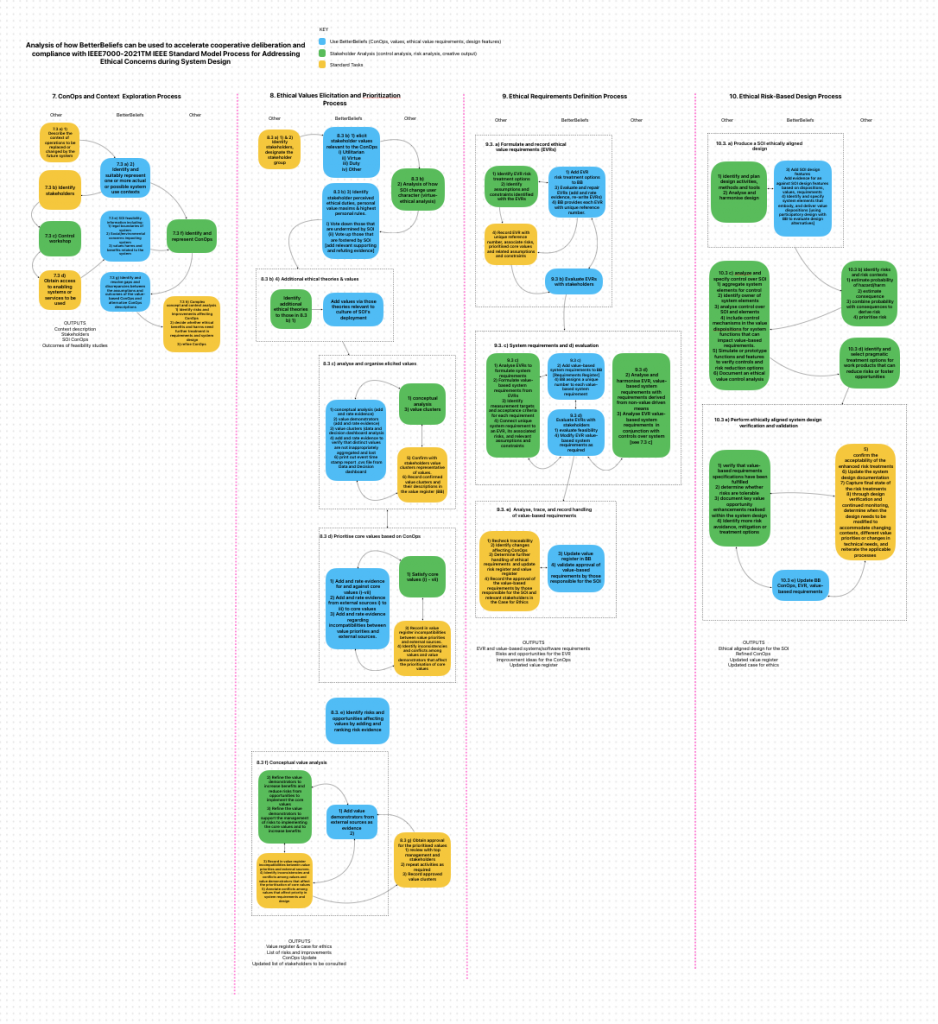
The hardest thing about building ethical IT systems can be translating from abstract, normative ethical theories and values into good engineering practices and system requirements within a risk management framework.
Value-based engineering (VBE) was proposed in 2015 [1] to solve this challenge and the ideas expressed have been collaboratively developed over a five-year standardization process resulting in the IEEE 7000TM standard, “A Model process for addressing Ethical Concerns during System Design” (“the standard”) [2].
VBE expressed through the standard seeks to ensure that value harms and benefits are systematically and technically addressed and monitored through a traceable, replicable and iterative process.
BetterBeliefs (BB) can be used as a tool to help compliance with the standard and optimised prioritisation of stakeholder viewpoints and decision making including:
- determining the appropriate context of operations (ConOps) of a system of interest (SOI),
- deciding what ethical values needed to be considered to the value-based system requirements and
- creating design features needed to address ethical concerns during system design.
The standard requires values to be proposed and systemically evaluated and prioritised using external evidence sources as well as drawing on the expertise of stakeholders.
Designed as an intuitive and scientific social platform, BB encourage the expression of diverse hypotheses as well as the facility to add supporting and refuting evidence to affect the prioritisation of hypotheses via two metrics: Degree of Belief (DoB) and Weight of Evidence (WoE).
The DoB metric captures supporting and dissenting votes on hypotheses on the platform. It takes the total upvotes and downvotes to create a likelihood that a hypothesis is true given stakeholder belief in it using Bernoulli-Beta distributions with 95% credible intervals represented to users.
The WoE metric captures both the quality and quantity of evidence determined by the number of evidence items, whether they constitute supporting or refuting evidence for the hypothesis in question, how each item is rated for quality by stakeholders (out of five stars) as well as the total number of evidence-item rankings by stakeholders.
BetterBeliefs provides the structure, justification and traceability needed to explore diverse potential contexts of operations for a system of interest (SOI), as well as establishing and maintaining a value register, value-based system requirements and design features based on the systemic prioritisation by stakeholders.
Read more about BetterBeliefs in the academic literature [3,4], as a tool to create a framework for ethical AI in Defence and when the platform was used during Responsible AI in the Military Domain (REAIM) Summit, 15-16 February, 2023, The Hague . Download process diagram for using BB with IEEE7000-2021TM here.
Contact BetterBeliefs at info@betterbeliefs.com.au to discuss using BetterBeliefs for your value-based engineering project.
References
[1] Spiekermann, S. (2015). Ethical IT innovation: A value-based system design approach. CRC Press [2] Spiekermann, S., & Winkler, T. (2022). Value-Based Engineering With IEEE 7000. IEEE Technology and Society Magazine, 41(3), 71-80. https://ieeexplore.ieee.org/document/9893523 [3] Pearce, T. R., Desouza, K., Wiewiora, A., Devitt, S. K., Mengersen, K., & Chowdhury, A. K. (2022). Debiasing Crowdsourcing and Collective Intelligence for Open Innovation with Novel Information System Affordances. 19th Conference of the Italian Chapter of AIS and the 14th Mediterranean Conference on Information Systems, Catanzaro. https://eprints.qut.edu.au/235920/ [4] Devitt, S. K., Pearce, T. R., Chowdhury, A. K., & Mengersen, K. (2022). A Bayesian social platform for inclusive and evidence-based decision making. In M. Alfano, C. Klein, & J. de Ridder (Eds.), Social Virtue Epistemology. Routledge. https://arxiv.org/abs/2102.06893


Leave a Reply
Your email is safe with us.